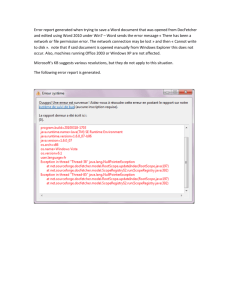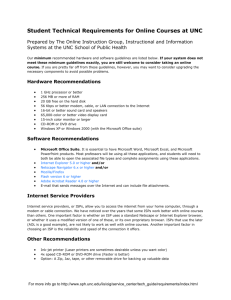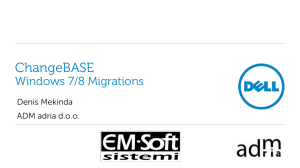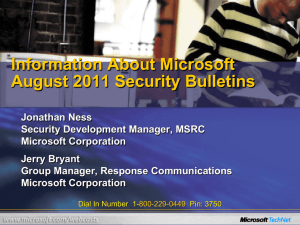tlp: white multi-state information sharing and analysis center cyber
advertisement
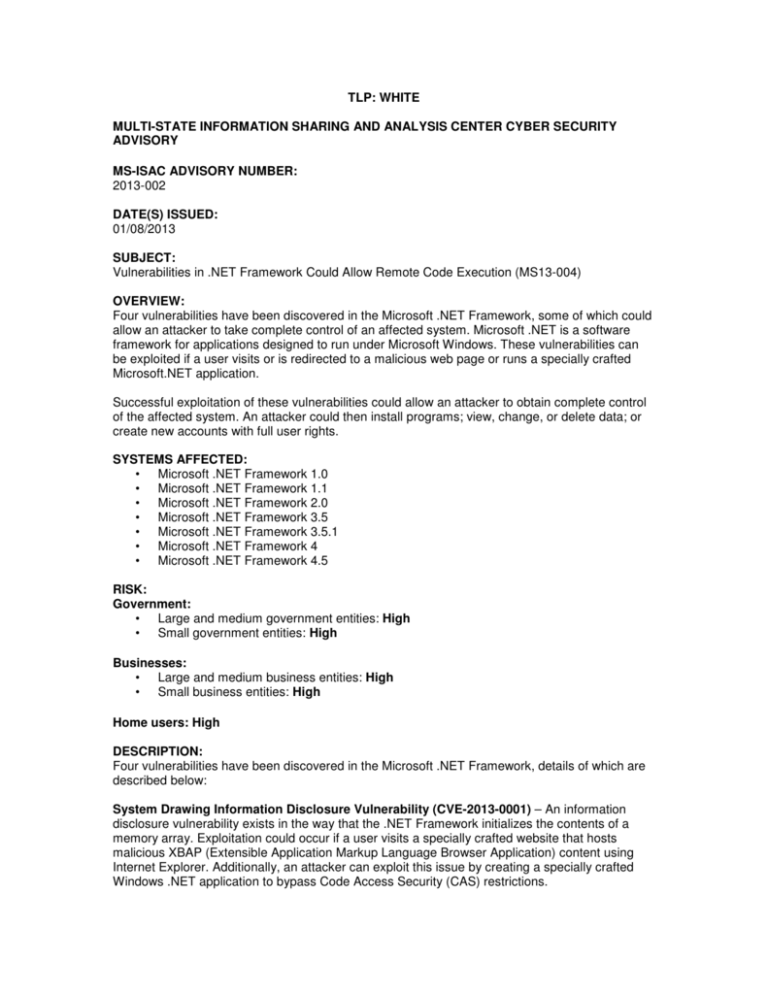
TLP: WHITE MULTI-STATE INFORMATION SHARING AND ANALYSIS CENTER CYBER SECURITY ADVISORY MS-ISAC ADVISORY NUMBER: 2013-002 DATE(S) ISSUED: 01/08/2013 SUBJECT: Vulnerabilities in .NET Framework Could Allow Remote Code Execution (MS13-004) OVERVIEW: Four vulnerabilities have been discovered in the Microsoft .NET Framework, some of which could allow an attacker to take complete control of an affected system. Microsoft .NET is a software framework for applications designed to run under Microsoft Windows. These vulnerabilities can be exploited if a user visits or is redirected to a malicious web page or runs a specially crafted Microsoft.NET application. Successful exploitation of these vulnerabilities could allow an attacker to obtain complete control of the affected system. An attacker could then install programs; view, change, or delete data; or create new accounts with full user rights. SYSTEMS AFFECTED: • Microsoft .NET Framework 1.0 • Microsoft .NET Framework 1.1 • Microsoft .NET Framework 2.0 • Microsoft .NET Framework 3.5 • Microsoft .NET Framework 3.5.1 • Microsoft .NET Framework 4 • Microsoft .NET Framework 4.5 RISK: Government: • Large and medium government entities: High • Small government entities: High Businesses: • Large and medium business entities: High • Small business entities: High Home users: High DESCRIPTION: Four vulnerabilities have been discovered in the Microsoft .NET Framework, details of which are described below: System Drawing Information Disclosure Vulnerability (CVE-2013-0001) – An information disclosure vulnerability exists in the way that the .NET Framework initializes the contents of a memory array. Exploitation could occur if a user visits a specially crafted website that hosts malicious XBAP (Extensible Application Markup Language Browser Application) content using Internet Explorer. Additionally, an attacker can exploit this issue by creating a specially crafted Windows .NET application to bypass Code Access Security (CAS) restrictions. WinForms Buffer Overflow Vulnerability (CVE-2013-0002) - An elevation of privilege vulnerability exists in the way that the .NET Framework validates the number of objects in memory before copying to an array. Exploitation could occur if a user visits a specially crafted website that hosts malicious XBAP content using Internet Explorer. Additionally, an attacker can exploit this issue by creating a specially crafted Windows .NET application to bypass CAS restrictions. By default, Internet Explorer 9 and Internet Explorer 10 prevent XAML, which is used by XBAPs, from running in the Internet Zone. Internet Explorer 6, Internet Explorer 7, and Internet Explorer 8 are configured to prompt the user before running XAML, which is used by XBAPs in the Internet Zone. S.DS.P Buffer Overflow Vulnerability (CVE-2013-0003) - An elevation of privilege vulnerability exists in the way that the .NET Framework validates the size of objects in memory before copying to an array. Exploitation could occur if a user visits a specially crafted website that hosts malicious XBAP content using Internet Explorer. Additionally, an attacker can exploit this issue by creating a specially crafted Windows .NET application to bypass CAS restrictions. Double Construction Vulnerability (CVE-2013-0004) - An elevation of privilege vulnerability exists in the way that the .NET Framework validates the permissions of an object in memory. Exploitation could occur if a user visits a specially crafted website that hosts malicious XBAP content using Internet Explorer. Additionally, an attacker can exploit this issue by creating a specially crafted Windows .NET application to bypass CAS restrictions. By default, Internet Explorer 9 and Internet Explorer 10 prevent XAML, which is used by XBAPs, from running in the Internet Zone. Internet Explorer 6, Internet Explorer 7, and Internet Explorer 8 are configured to prompt the user before running XAML, which is used by XBAPs in the Internet Zone. Successful exploitation of these vulnerabilities could result in the execution of the attackersupplied code and allow the attacker to obtain complete control of the affected system. An attacker could then install programs; view, change, or delete data; or create new accounts with full user rights. RECOMMENDATIONS: We recommend the following actions be taken: • Apply appropriate patches provided by Microsoft to vulnerable systems immediately after appropriate testing. • Run all software as a non-privileged user (one without administrative privileges) to diminish the effects of a successful attack. • Remind users not to visit un-trusted websites or follow links provided by unknown or untrusted sources. • Unless there is a business need to do otherwise, consider disabling XAML browser applications (XBAP) in Internet Explorer 6, 7, 8. By default, Internet Explorer 9 and Internet Explorer 10 prevent XAML, which is used by XBAPs REFERENCES: Microsoft: http://technet.microsoft.com/en-us/security/bulletin/ms13-004 CVE: http://www.cve.mitre.org/cgi-bin/cvename.cgi?name=CVE-2013-0001 http://www.cve.mitre.org/cgi-bin/cvename.cgi?name=CVE-2013-0002 http://www.cve.mitre.org/cgi-bin/cvename.cgi?name=CVE-2013-0003 http://www.cve.mitre.org/cgi-bin/cvename.cgi?name=CVE-2013-0004 SecurityFocus: http://www.securityfocus.com/bid/57113 http://www.securityfocus.com/bid/57114 http://www.securityfocus.com/bid/57124 http://www.securityfocus.com/bid/57126 Multi-State Information Sharing and Analysis Center Center for Internet Security 31 Tech Valley Drive, Suite 2 East Greenbush, NY 12061 (518) 266-3460 1-866-787-4722 soc@msisac.org TLP: WHITE Traffic Light Protocol (TLP): WHITE information may be distributed without restriction, subject to copyright controls. http://www.us-cert.gov/tlp/ This message and attachments may contain confidential information. If it appears that this message was sent to you by mistake, any retention, dissemination, distribution or copying of this message and attachments is strictly prohibited. Please notify the sender immediately and permanently delete the message and any attachments.
